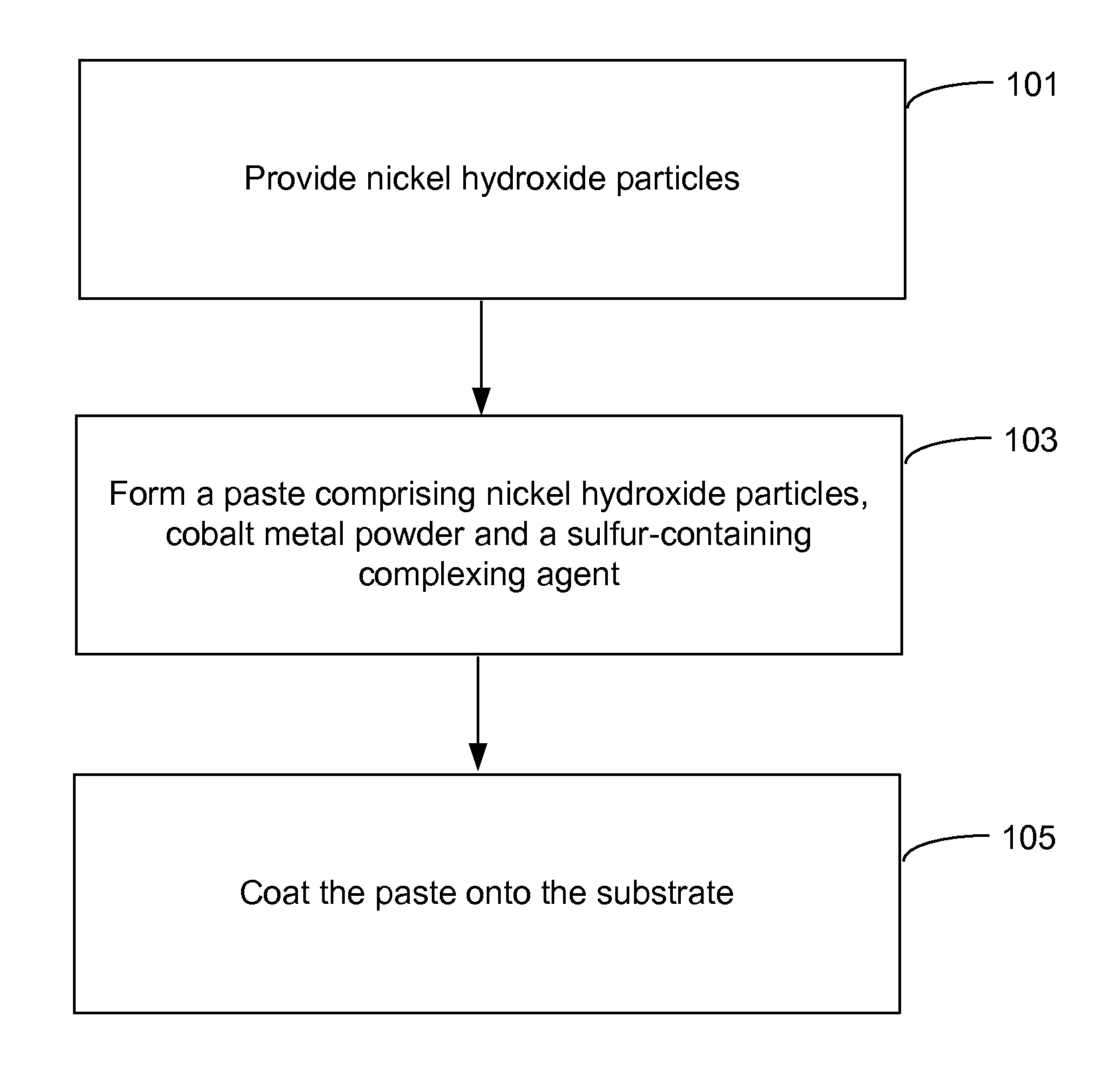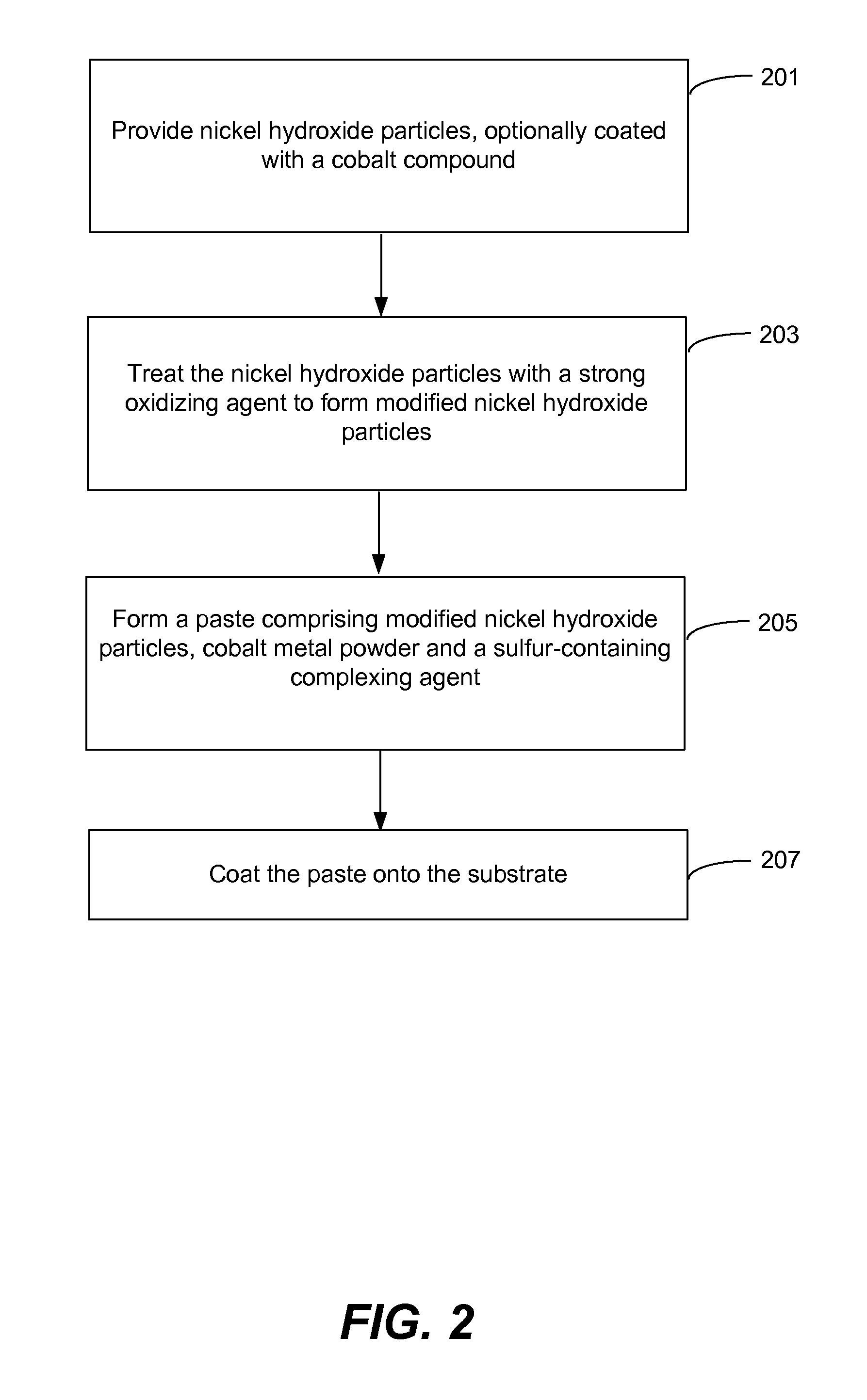Pasted nickel hydroxide electrode and additives for rechargeable alkaline batteries
a rechargeable alkaline battery and nickel hydroxide electrode technology, applied in the field of nickel batteries, to achieve the effects of reducing nickel electrode swelling, preventing particle peeling, and minimizing cobalt migration
- Summary
- Abstract
- Description
- Claims
- Application Information
AI Technical Summary
Benefits of technology
Problems solved by technology
Method used
Image
Examples
experimental examples
Example 1
[0149]FIG. 10 shows the discharge curves of the Ni / Zn batteries using the nickel hydroxide electrode prepared using surface-oxidized nickel hydroxide particles with 4 wt. % and 6 wt. % metal Co powder additives at 12 A discharge current. The greater amount of added cobalt in the pasted nickel hydroxide electrode leads to an increase in the capacity utilization of the nickel hydroxide particles. However, the large amount of added cobalt powder in the pasted nickel hydroxide electrode leads to a decrease in the discharge voltage of the Ni / Zn battery and to an increase in the battery temperature. Because the rechargeable alkaline batteries particularly for the HEV applications need high-rate charge and discharge capabilities, long cycle lifetime and higher temperature conditions, the nickel hydroxide electrode would benefit from a high amount of added cobalt metal.
example 2
[0150]FIG. 11 shows the discharge voltage and temperature of a Ni—Zn cell as a function of discharge time at 6 C discharge current (discharge current: 12 A) for cells having nickel positive electrode prepared with and without NaDDC addition. The cobalt amount in the pasted nickel hydroxide was 4% by weight. The electrode was prepared using surface-oxidized nickel hydroxide particles. The amount of added NaDDC in the pasted nickel hydroxide electrode was 0.1% by weight. The increased temperature of the battery with the NaDDC-free nickel hydroxide electrode during the discharge process was 27.0° C. The increased temperature of the battery with the 0.1 wt. % NaDDC additive in nickel hydroxide electrode during the discharge process was significantly smaller—22.2° C. The increase in the battery temperature using the NaDDC-containing nickel hydroxide electrode was about 4.8° C. less than that the increase in the battery using the regular nickel hydroxide electrode. The higher temperature ...
example 3
[0152]FIG. 13 illustrates discharge capacity of the Ni / Zn cells as a function of number of cycles. The Ni / Zn batteries were built by using the surface-oxidized nickel hydroxide with the addition of 4 wt. % Co and 0.1 wt. % NaDDC (or without addition of NaDDC in a control experiment). The batteries were cycled at a charge regime with 2 A constant current charge to 1.90 V and constant voltage charge to 90 mA end-of-charge current. The discharge current was 10 A. The temporary capacity dips appearing in the cycling curves correspond to 20 A discharge cycles followed by 24 hours rest at the 10th cycle and then resuming continuous cycling but resting at every 50th cycle. It is shown in FIG. 13 that the discharge capacity of the Ni / Zn battery having a NaDDC-containing nickel hydroxide electrode has a slow fading on the increase in the number of cycles. It is believed that the NaDDC addition in the pasted nickel hydroxide electrode leads to an efficient formation of CoOOH conductive networ...
PUM
| Property | Measurement | Unit |
|---|---|---|
| temperature | aaaaa | aaaaa |
| temperature | aaaaa | aaaaa |
| temperature | aaaaa | aaaaa |
Abstract
Description
Claims
Application Information
 Login to View More
Login to View More - R&D
- Intellectual Property
- Life Sciences
- Materials
- Tech Scout
- Unparalleled Data Quality
- Higher Quality Content
- 60% Fewer Hallucinations
Browse by: Latest US Patents, China's latest patents, Technical Efficacy Thesaurus, Application Domain, Technology Topic, Popular Technical Reports.
© 2025 PatSnap. All rights reserved.Legal|Privacy policy|Modern Slavery Act Transparency Statement|Sitemap|About US| Contact US: help@patsnap.com



